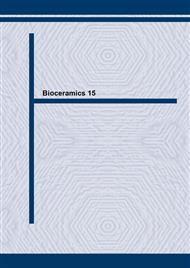[1]
L. L. Hench: J. Am. Ceram. Soc. Vol. 81 (1998), p.1705.
Google Scholar
[2]
R. H. J. Hannink and M. V. Swain: Annu. Rev. Mater.Sci. Vol. 24 (1994), p.359.
Google Scholar
[3]
J. M. Wu and T. S. Yeh: J. Mater. Sci. Vol. 23 (1988), p.3771.
Google Scholar
[4]
V. V. Silva, F. S. Lameiras and R. Z. Domingues: Composites Sci. and Tech. Vol. 61 (2001), p.301.
Google Scholar
[5]
R. R. Rao and T.S. Kannan: Mater. Sci. Eng. Vol. 20 (2002), p.187.
Google Scholar
[6]
E. Adolfsson, P. Alberius-Henning, and L. Hermansson: J. Am. Ceram. Soc. Vol. 83 (2000), p.2798.
Google Scholar
[7]
M. Takagi, M. Mochida, N. Uchida, K. Saito, and K. Uematsu: J. Mater. Sci. in Medicine: Vol. 3 (1992), p.199. Acknowledgements Authors gratefully thank the Biomaterials Unit in University of New South Wales and Materials Division in Australia Nuclear Science and Technology Organisation for the assistance in the experimental work. Fig. 4 Fracture surface of HAp-TZP FGMs. (a) HAp-20 vol%TZP; (b) HAp-80 vol%TZP a 30µµµµm b 30µµµµm
DOI: 10.1007/bf00713450
Google Scholar


